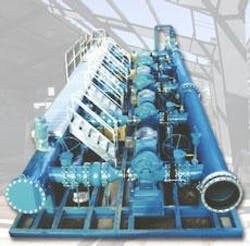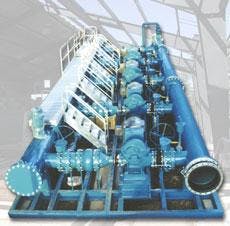Prefabricated Pumping Systems Grow in Size, Sophistication
By Tom Levey and Stephen Jeffus
Some engineering firms labor under the misconception that prefabricated systems are too small to handle the enormous volumes of water that municipalities and private water companies transport. Though once limited to certain size projects, technological innovations and manufacturing breakthroughs have dramatically expanded the application of prefabricated pump systems over the past several years.
Just as the introduction of fiber optics and DSL dramatically opened up the "information pipeline," technology has significantly changed the amount of fluid that a prefabricated system can move. By working closely with engineering and consulting firms, manufacturers have pioneered new ways to build systems on a much larger scale that can cost-effectively and efficiently serve municipalities and water works companies. Advancements like CAD and CNC devices have made it practical, and preferable, to prefabricate custom pump stations ranging from 10 gpm to over 15,000 gpm.
Size is No Barrier
The most important industry innovation has been the emergence of new software tools that allow designers to create pump station "modules." This has made building large prefabricated pump systems commonplace for a prefabricated pump station manufacturer.
While once thought to be impossible, complex systems can now be built to tight tolerances and delivered anywhere in North America. For instance, a 60-foot-long station was transported to a site on six flatbed trucks and assembled in a few days, all without a hitch, to the city of El Dorado, AR, in 2001.
El Dorado is a picturesque city that experienced a population boom in the 1990's. The city's original wells were built too close together, so that water could not be replenished fast enough to meet the city's water demands. In addition, El Dorado also experienced drought conditions over the past few years. To make it through another summer, the city elected to create a new water works system that could meet the growing demand.
El Dorado built new wells and elected to install a prefabricated pumping system to siphon water from a pair of 2 million gallon ground storage tanks and deliver it to the distribution system. The assembled modular station's skid measured 16' x 58' with an outflow capacity of 8,000 gpm and internally lined the pipe system with fusion-bonded epoxy. The station included smooth controllers to avoid pipe surges and water hammer. Using CAD drawings, project engineers precisely matched the station's footprint with the correct electrical wiring and piping design.
The complete skid was designed and built to be broken into six sections. It was completely fabricated, assembled, tested and disassembled to ensure that all centerlines were met and ensure that all the proverbial "pieces of the puzzle" formed a seamless closure and completely uninterrupted picture.
According to Craig Johnson, P.E. Project Manager at Carter-Burgess, Inc., a firm specializing in planning engineering, architecture and construction management, "Typically, the size and pumping capacity we needed was met with a site-built station. But, a manufacturing firm was able to meet our needs, and most importantly meet our deadlines with one of their modular products."
The system was delivered on time and within budget. The evolving technology incorporated into modular pumping systems can allow municipalities to create more efficient water works systems. Systems can be designed to pump large volumes of water and allow for easy expansion to keep up with growing population demands.
Cost Comparisons
Prefabricated pumping systems are no longer small, "cookie cutter" or "one size fits all" solutions. One of the most important advantages of a prefabricated pump station is that the modular units usually cost much less to design, manufacture and install than that of a traditional stick built system.
With stick-built systems, the full burden is placed on engineers and contractors who may not be versed on the latest pump system technologies. In those cases, an engineering firm must design the system and garner components from various manufacturers that are delivered for final assembly at the site. During this process, setbacks can occur, such as weather delays, job site manpower coordination and late equipment/supply deliveries that usually create cost overruns.
Prefabricated systems are more cost-effective because parts and pumps have been purchased in bulk, standard components like controls have been pre-assembled and people experienced in designing, building and testing stations make certain it meets every specification. Once complete, the station arrives on site installation ready; within a few days, possibly even hours, it is generally on-line and ready to pump.
With the single source accountability of prefabricated stations, engineers, contractors and end-users no longer need to deal with multiple companies or various warranties. One call is made to a single company and a technician is dispatched to correct the problem wherever it may be found within the system.
With stick built systems, the opposite is true. A myriad of problems can crop up; solving them can prove to be a challenge as well. With mechanical problems, the result is often costly, as well as time consuming to repair.
Another advantage of working with a prefabricated systems manufacturer is their ability to integrate technological advances within products. For instance, a product is currently on the market that increases the energy savings of a VFD system by adjusting discharge output based on demand. By using sophisticated flow meters to take precise measurements, this software ultimately lowers leakage rates.
In addition, some manufacturers leverage electronic tools to decrease the time it takes for the submittal and design process. Offering electronic submittals and product configuration tools will greatly decrease the amount of time engineers have to spend on the pumping aspect of their projects.
By studying and understanding pump applications across industries, high-end prefabricated manufacturers have created options for engineers that help them add more value to their clients. Combining this "best practice" knowledge based on thousands of pump stations with an engineering firm's overall project management skills creates a powerful synergy.
Looking Ahead
Many industries have already adopted the prefabricated model. Almost all of the water towers and tanks being installed today were built and shipped for on-site installation because of the considerable savings in time and money. The golf industry long ago adopted the concept of prefabricated pumping systems to the extent that it is now the standard. As technology has allowed size and cost barriers to be eliminated, it is only a matter of time before incorporating prefabricated pump systems becomes standard operating procedure for water works and municipalities worldwide.
About the Authors Tom Levey is Director of Marketing at Flowtronex PSI Inc. Stephen H. Jeffus, the Director of WaterWorks Application Engineers for Flowtronex PSI, is an experienced municipal water industry veteran.

